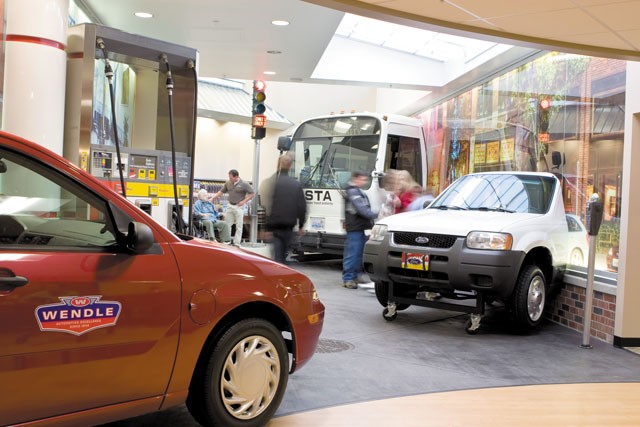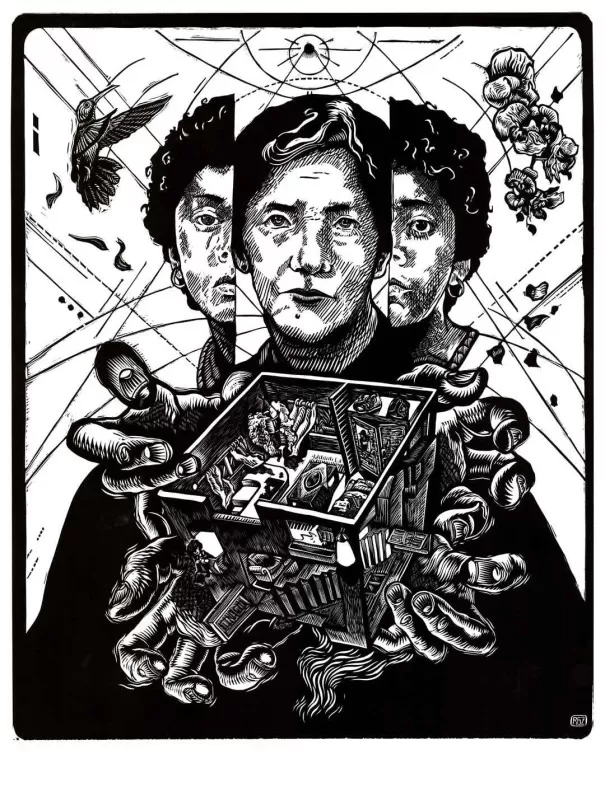Standing inside the new therapy center at St. Luke’s Rehabilitation Institute, you feel like you’ve stumbled on the site of an accident. The front of an old STA bus appears to have plunged through the southwest wall of the high-ceilinged, concrete-floored room. Beside it, the nose of a small white SUV has burst into the room, stopping just in time to avoid a head-on collision with a sedan that crashed in through the opposite wall.
But this isn’t a disaster — it’s the future of physical rehab in Spokane.
Opened at the end of November, “St. Luke’s Community” was designed as a practice space for patients who have suffered from stroke, spinal injuries, or other debilitating conditions. Designed by Nystrom Olson in what used to be the hospital’s open-air smoking lounge, the 2,200-square-foot, $700,000 facility is stuffed with ten detailed replicas of real-life milieus patients will have to navigate after leaving rehab.
Here’s that city bus — a real city bus, donated by the Spokane Transit Authority — where patients can practice using the lift. There are two Wendle Motors Fords, a Shell gas pump, a tiny Tomato Street restaurant tableau, with a low table and a small booth. In the next room are a bank teller window, a tiny hotel lobby, an office cubicle (complete with printer and imposing file cabinets) and an aisle pulled straight out of Walgreens.
In the coming months, the center also plans to add a (functional) Redbox DVD dispenser and a sliver of fuselage from a Southwest Airlines jet, which is still en route from the United Kingdom.
Similar facilities exist in Seattle, says St. Luke’s therapist Chris Clutter, but they’re bland and generic. The actual STA bus and the Walgreens display make for a more realistic experience. “We truly have our community [here],” she says.
Indeed, the walls are covered in nearly-life-size photographs of Spokane street scenes. There’s Mizuna, on Howard Street. There’s Auntie’s Books.
In front of a giant photograph of the Zola/Rocket Bakery block, Carolyn Bullock, a 65-year-old rehab patient, practices getting in and out of a small sedan. Guided by her therapist, she rises slowly from her wheelchair and takes discrete, determined steps toward the open car door. There is a technique to each movement. Walker here. Foot here. Turn. Sit down. Bring this leg up. Support yourself here.
It’s a routine that many of us perform without thought, in one fluid movement. But for Bullock and others, it’s a challenging re-education.
“You’re learning to live with the new body you have,” says Neil Gustafson, 34, a former St. Luke’s patient who now volunteers there. At 18, Gustafson was in a car accident that broke his neck at the fifth cervical vertebra, leaving him partially paralyzed from the neck down. He spent six months in the hospital and in-patient care at St. Luke’s, then another six in outpatient rehab.
All the little things he knew how to do with his old body — brushing his teeth, combing his hair — had to be relearned in his new one.
But almost more challenging than the tasks themselves, he says, was the stress of doing them with the eyes of an impatient world on him.
“You’re trying to find your open window in a community that’s just being a busy city. People are waiting [behind you] to get gas at the gas pump. I lost my ATM card in the beginning because I took too long at the ATM machine,” he says. “[But] here, you’re not holding up a bus. You don’t have a long line at the grocery check-out. If you fall in here, big deal. In a restaurant, that’s a different situation.”
Gustafson stresses that he thinks true recovery will always require those uncomfortable public situations — the real-world application — but he marvels at what St. Luke’s now offers its patients.
“This is moving [St. Luke’s] to the next level,” he says. “To the upper tier of rehab centers across the country.”
St. Luke’s continues to raise funds for the St. Luke’s Community. You can donate online at www.st-lukes.org/community or by calling the INHS Foundation office at (509) 473-6099.
















